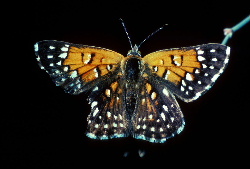- Lange's metalmark butterfly
Taxobox
name = Lange's metalmark butterfly

image_width = 240px
status = LE
status_system = ESA
regnum =Animal ia
phylum =Arthropod a
classis =Insect a
ordo =Lepidoptera
subordo =Ditrysia
infraordo =Rhopalocera
superfamilia =Papilionoidea
familia =Riodinidae
subfamilia =Riodininae
genus = "Apodemia "
species = "A. mormo"
subspecies = "A. m. langei
trinomial = "Apodemia mormo langei"
trinomial_authority = Comstock, 1938 "Apodemia mormo langei", also known as Lange's Metalmark Butterfly, is an endangeredNorth America n butterfly. It is asubspecies of theMormon metalmark and belongs to the familyRiodinidae .Description
Lange's metalmark is a fragile, brightly colored butterfly in the Riodinidae (metalmark) family. Adult wingspan varies from 1 to convert|1.5|in|mm|sing=on. Dorsal wings are largely black with white spots. Red-orange coloration extends through the inner forward half of the forewing, the hindwing bases, and a small central patch subtended by black. Below, the wings have a more muted pattern of gray, white, black, and orange.
tatus and distribution
The butterfly has been classified in the
USA as a "Federal Endangered Species" (Federal Register 41:22044; June 1, 1976).Lange’s metalmark butterfly was historically restricted to sand dunes along the southern bank of the Sacramento-San Joaquin River, and is currently found only at Antioch Sand Dunes in Contra Costa County, USA. Most of the habitat is now part of the Antioch Dunes National Wildlife Refuge (administered by the Don Edwards San Francisco Bay National Wildlife Refuge Complex). Recent population counts have ranged from several hundred to more than a thousand individuals. While the Antioch Dunes Recovery Plan of 25 April 1984 has been put under action, no critical habitat has been designated as yet.
In the early 1900s, the isolated dune habitat in the delta began to experience a dramatic change as human development expanded. The easily-accessible sand was harvested to make bricks. Large-scale sand mining and industrial development fragmented the sand dune habitat until only a small portion of the original ecosystem remained. Nonnative grasses and vegetation encroached on the sand dunes to crowd the few remaining endangered plants. By the time the Antioch Dunes Refuge was established, only a few acres of remnant dune habitat supported the last natural populations of Antioch Dunes evening-primrose, Contra Costa wallflower and Lange's metalmark.
A reservoir of moving sand is essential to maintain the dynamic ecology of the dunes, as moving sand opens areas for the establishment of seedling plants. Roto-tilling has contributed to the invasion of exotic vegetation that stabilizes the remaining sand-dune habitat and competes with native dune vegetation. Habitat improvement activities have included dune restoration, hand-clearing of non-native plant species, planting buckwheat seedlings and restriction of public access to avoid trampling and fire.
Life History
All the life stages of Lange's metalmark butterflies are found close to the larval food plant, buckwheat (Eriogonum nudum ssp. auriculatum). The eggs are deposited on buckwheat leaves near the leaf petiole throughout the mating flight that occurs during August and September. Larvae hatch during the rainy months. Larvae are known to feed only on buckwheat. The adults may use buckwheat, butterweed ("Senecio douglasii") and snakeweed ("Gutierrezia divergens") for nectar. Lange's metalmark butterfly also use lupine ("Lupinus albifrons"), for mating.
Unlike the many butterfly species that have several generations a year, Lange's metalmark has only one. The fecundity of the wild individuals is low. Detailed life history and physiological requirements of this species are unknown.
References
* Arnold, R. A. 1980. Ecological studies of 6 endangered butterflies: island biogeography, patch dynamics, and the design of nature preserves. PhD thesis. Univ. of Calif., Berkeley. Berkeley, CA.
* Howe, W. H. (ed.). 1975. The butterflies of North America. Doubleday and Co. Garden City, NY.
* Opler, P. A. and J. A. Powell. 1962. Taxonomic and distributional studies on the western components of the "Apodemia mormo" complex (Riodinidae). Journal of the Lepidoptera Society 15:145-171.
* Thelander, C. ed. 1994. Life on the edge: a guide to California's endangered natural resources. BioSystem Books. Santa Cruz, CA. p 432-433.
* U.C. Berkeley, Essig Museum of Entomology. California's Endangered Insects.
* U.S. Fish & Wildlife Service. 1984. Antioch Dunes Recovery Plan. Portland, Oregon.
Wikimedia Foundation. 2010.
